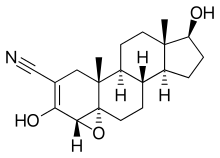Trilostane
Trilostane, sold under the brand names Desopan, Modrastane, and Modrenal among others, is a steroidogenesis inhibitor which is used in the treatment of Cushing's syndrome.[1][2][3]
 | |
| Clinical data | |
|---|---|
| Other names | 4α,5-Epoxy-3,17β-dihydroxy-5α-androst-2-ene-2-carbonitrile |
| AHFS/Drugs.com | Monograph |
| Routes of administration | By mouth |
| ATC code | |
| Legal status | |
| Legal status |
|
| Pharmacokinetic data | |
| Metabolism | Hepatic |
| Elimination half-life | 8 hours |
| Identifiers | |
IUPAC name
| |
| CAS Number | |
| PubChem CID | |
| IUPHAR/BPS | |
| DrugBank | |
| ChemSpider | |
| UNII | |
| KEGG | |
| ChEBI | |
| ChEMBL | |
| CompTox Dashboard (EPA) | |
| ECHA InfoCard | 100.033.743 |
| Chemical and physical data | |
| Formula | C20H27NO3 |
| Molar mass | 329.433 g/mol g·mol−1 |
| 3D model (JSmol) | |
SMILES
| |
InChI
| |
| | |
It was withdrawn from human use in the United States market in April 1994.[4][5] The drug was previously available in the United Kingdom for use in humans under the brand name Modrenal for the treatment of Cushing's disease and for breast cancer.[6][7][8] It was approved in the United States in 2008 for the treatment of Cushing's disease (hyperadrenocorticism) in dogs under the brand name Vetoryl.[9] It was available by prescription in the UK under the Vetoryl brand name for some time before it was approved in the US.[10] The drug is also used to treat the skin disorder Alopecia X in dogs.[4][11][12] It is also the first drug approved to treat both pituitary- and adrenal-dependent Cushing's in dogs. This prescription drug works by stopping the production of cortisol in the adrenal glands.[13][14] In studies of the drug, the most common side effects were vomiting, lack of energy, diarrhea, and weight loss. Trilostane should not be given to a dog that:
- has kidney or liver disease;[10][15]
- takes certain medications used to treat heart disease;
- is pregnant, nursing or intended for breeding [10][15]
The safety and effectiveness of trilostane were shown in several studies. Success was measured by improvements in both blood test results and physical symptoms (increased appetite and activity level, and decreased panting, thirst and urination).[8][16]
Only one other drug, Anipryl (veterinary brand name) selegiline, is FDA-approved to treat Cushing's disease in dogs, but only to treat uncomplicated, pituitary-dependent Cushing's.[17] The only previous treatment for the disease was the use of Mitotane (brand name Lysodren) off-label.[16][18]
It has been used as a progesterone inhibitor.[19]
A number of compounding pharmacies in the US sell the product. Since the US approval of Vetoryl in December 2008,[9] compounding pharmacies are no longer able to use a bulk drug product for compounding purposes, but must prepare the compounded drug from Vetoryl.[20]
It is an inhibitor of 3β-hydroxysteroid dehydrogenase (3β-HSD), as well as of other enzymes involved in steroidogenesis.[21]
Chemistry
The compound is prepared from testosterone in a four-step synthesis.
References
- George W.A Milne (8 May 2018). Drugs: Synonyms and Properties: Synonyms and Properties. Taylor & Francis. pp. 34–. ISBN 978-1-351-78989-9.
- Komanicky P, Spark RF, Melby JC (1978). "Treatment of Cushing's syndrome with trilostane (WIN 24,540), an inhibitor of adrenal steroid biosynthesis". J. Clin. Endocrinol. Metab. 47 (5): 1042–51. doi:10.1210/jcem-47-5-1042. PMID 233687.
- Forney, Barbara. "Trilostane for Veterinary Use". Wedgewood Pharmacy. Retrieved 5 April 2011.
- Cook, Audrey K. (1 February 2008). "Trilostane: A therapeutic consideration for canine hyperadrenocorticism". DVM 360. Retrieved 5 April 2011.
- "Trilostane consumer information". Drugs.com. 4 January 2009. Archived from the original on 12 February 2008. Retrieved 3 April 2011.
- "Modrenal consumer information". Drugs.com UK. Retrieved 3 April 2011.
- "Modrenal". electronic Medicines Compendium UK. Retrieved 3 April 2011.
- Braddock, JA, Church, DB, Robertson, ID, Watson, ADJ (October 2003). "Trilostane treatment in dogs with pituitary-dependent hyperadrenocorticism" (PDF). Australian Veterinary Journal. pp. 18 of 63. Retrieved 5 April 2011. (PDF)
- "Vetoryl approval information". Food and Drug Administration. 5 December 2008. Retrieved 3 April 2011.
- "Vetoryl-Contraindications". NOAH Compendium of Animal Health-National Office of Animal Health UK. Retrieved 3 April 2011.
- Hillier, Andrew (2006). "Alopecia: Is an Endocrine Disorder Responsible?" (PDF). Ohio State University Endocrinology Symposium. p. 12 of 67. Retrieved 8 April 2011. (PDF)
- Cerundolo, Rosario; Lloyd, David H.; Persechino, Angelo; Evans, Helen; Cauvin, Andria (2004). "Treatment of Canine Alopecia X with trilostane" (PDF). European Society of Veterinary Dermatology. Retrieved 16 May 2011. (PDF)
- Reusch, Claudia E. (2006). "Trilostane-5 Years of Clinical Experience for the Treatment of Cushing's Disease" (PDF). Ohio State University Endocrinology Symposium. pp. 17–19. Retrieved 5 April 2011. (PDF)
- Reusch, Claudia E. (2010). "Trilostane-A Review of a Success Story". World Small Animal Veterinary Association (WSAVA). Retrieved 5 April 2011.
- "Dechra US Datasheet-Vetoryl" (PDF). Dechra US. Retrieved 3 April 2011. (PDF)
- "Treating Cushing's Disease in Dogs". US Food and Drug Administration. Retrieved 3 April 2011.
- "Anipryl consumer information". Drugs.com Vet. Retrieved 3 April 2011.
- Reine, NJ. (2007). "Medical management of pituitary-dependent hyperadrenocorticism: mitotane versus trilostane". Clinical Tech-Small Animal Practice. 22 (1): 18–25. doi:10.1053/j.ctsap.2007.02.003. PMID 17542193.
- le Roux PA, Tregoning SK, Zinn PM, van der Spuy ZM (June 2002). "Inhibition of progesterone secretion with trilostane for mid-trimester termination of pregnancy: randomized controlled trials". Human Reproduction (Oxford, England). 17 (6): 1483–9. doi:10.1093/humrep/17.6.1483. PMID 12042266.
- "VETORYL (trilostane) Capsules Letter - Pharmacy Professionals". Food and Drug Administration. 11 September 2009. Retrieved 3 April 2011.
- de Gier J; Wolthers CH; Galac S; Okkens AC; Kooistra HS (April 2011). "Effects of the 3β-hydroxysteroid dehydrogenase inhibitor trilostane on luteal progesterone production in the dog". Theriogenology. 75 (7): 1271–9. doi:10.1016/j.theriogenology.2010.11.041. PMID 21295836.
External links
- Trilostane (Vetoryl) information from Veterinary Medicines Directorate, UK. Includes precautionary use regarding concurrent medical conditions, possible side effects, and possible interaction with other drugs. (PDF)